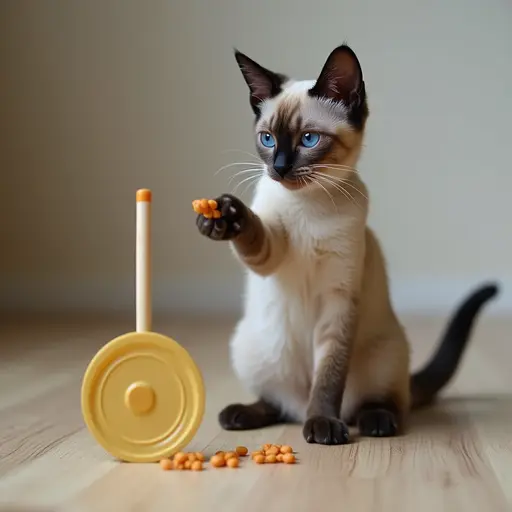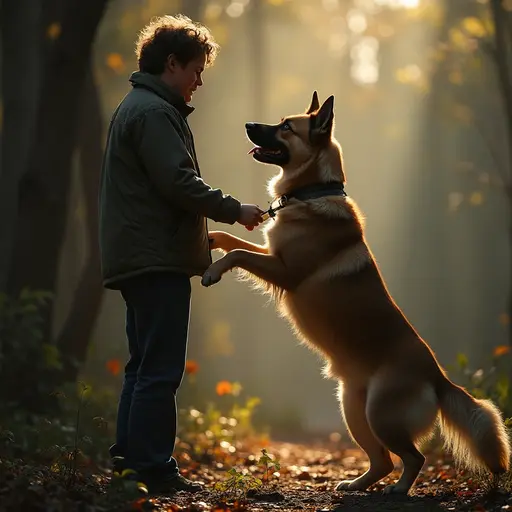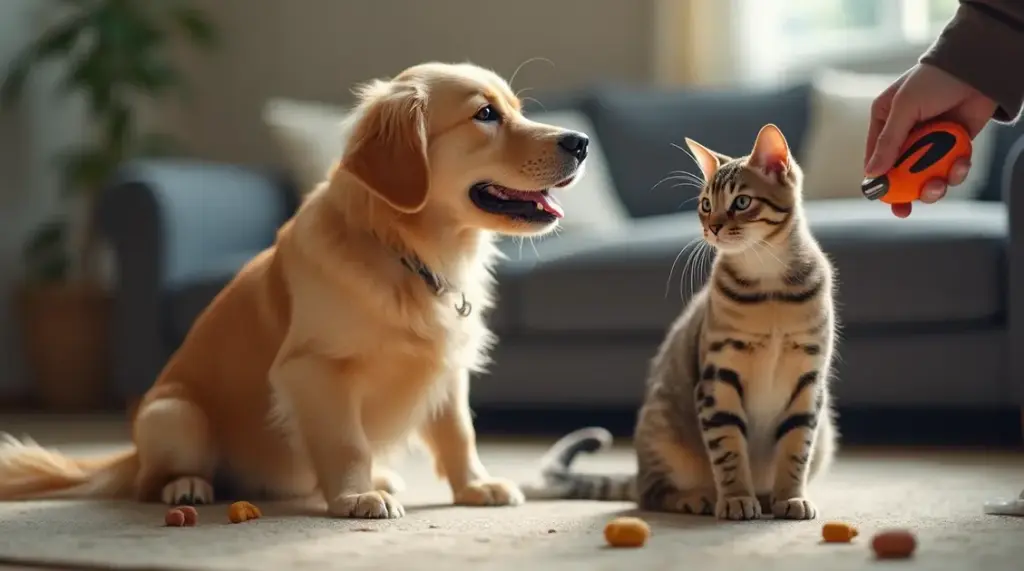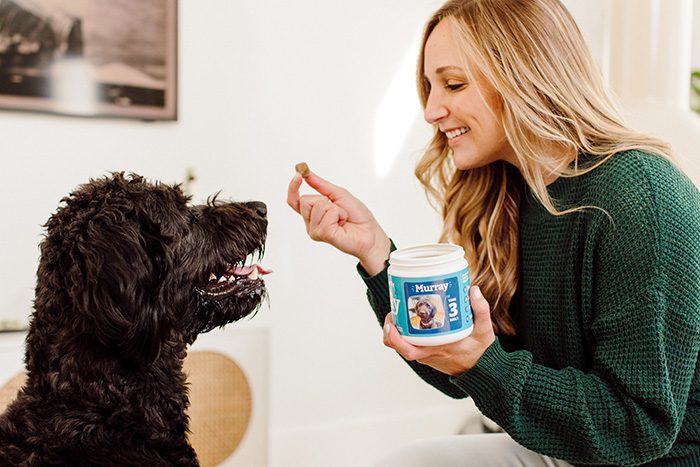Are you looking for a fun, effective way to train your furry friend? Clicker training is a powerful method that uses positive reinforcement to teach dogs and cats new behaviors, tricks, and commands. Whether you’re a first-time pet owner or a seasoned pro, this beginner’s guide will walk you through everything you need to know about clicker training for dogs and cats.
From understanding the science behind this training technique to mastering step-by-step instructions, you’ll discover how to strengthen your bond with your pet while encouraging good behavior. Ready to transform your pet’s learning experience? Let’s dive into the world of clicker training!
What is Clicker Training for Dogs and Cats?

Imagine trying to explain to your dog why sitting patiently earns praise or teaching your cat to high-five without confusion. Traditional training often leaves pets guessing, but clicker training cuts through the noise with clarity.
Developed from animal behavior studies (yes, it’s rooted in marine mammal training!), this method relies on a simple handheld device that makes a distinct clicking sound. The “click” acts as a precise signal, telling your pet exactly when they’ve done something right.
The Science Behind the Click
At its core, this approach is built on operant conditioning—a concept pioneered by psychologist B.F. Skinner. Animals repeat behaviors that lead to positive outcomes. Here’s how it works:
- The Click Marks the Moment: When your pet performs a desired action (like sitting), the clicker instantly “captures” that behavior. This bridges the gap between action and reward, eliminating guesswork.
- Rewards Reinforce Behavior: Follow the click with a treat, playtime, or affection. Over time, your pet associates the sound with success and repeats the action to earn more rewards.
- Consistency is Key: Unlike verbal praise, which can vary in tone or timing, the clicker’s sound is always the same. This consistency speeds up learning.
Why It Works for Both Dogs and Cats
You might think cats are too independent for structured training, but their curiosity and intelligence make them ideal candidates. Dogs, with their eagerness to please, thrive with clear communication. Here’s why it’s effective across species:
- Dogs: Motivated by food, toys, or praise, they quickly connect the click to rewards. Perfect for teaching obedience commands or curbing unwanted habits like jumping.
- Cats: Clicker training taps into their problem-solving instincts. Use it to redirect scratching, teach fun tricks (like “sit” or “fetch”), or even train them to use a human toilet.
A Universal Language for Pets
Whether you’re working with a playful puppy or a skeptical tabby, the clicker becomes a shared language. It’s not about dominance or discipline—it’s about clear communication. By focusing on what your pet does right instead of punishing mistakes, you build trust and enthusiasm. Ready to see how it works in practice? Let’s explore the tools and techniques to get started.
Why Clicker Training Works Wonders for Your Pet
Picture this: Your dog finally stops lunging at squirrels during walks, or your cat willingly steps into their carrier without a struggle. These aren’t just pipe dreams—clicker training makes them possible by focusing on what your pet does right. Unlike old-school methods that rely on scolding or leash corrections, this approach builds confidence and curiosity. Let’s unpack why it’s a game-changer.
Building Trust, Not Fear
Ever noticed how animals shut down when yelled at? Traditional training often creates stress, but clicker flips the script. By rewarding small successes—like your cat touching a target stick or your dog making eye contact—you create a safe space for learning.
- No More Guesswork: Pets don’t speak human language. The clicker’s consistent sound bridges that gap, saying, “Yes! That’s exactly what I wanted.”
- Empowerment Over Obedience: Instead of forcing compliance, you’re inviting your pet to problem-solve. A dog who chooses to sit for a treat learns faster than one coerced into it.
- Reduced Anxiety: Punishment-free methods are especially vital for rescue pets or timid animals. Clicker training’s predictability helps them feel secure.
For Dogs: Beyond “Sit” and “Stay”
While basic commands are a great start, the real magic happens when you dig deeper. Imagine teaching your pup to:
- Quietly greet guests instead of jumping.
- Retrieve your keys (or the TV remote!).
- Navigate agility courses with focus and joy.
The clicker’s precision helps dogs master complex tasks because they’re not just following orders—they’re actively participating in the process.
For Cats: Unlocking Hidden Potential
Yes, cats can be trained! Clicker sessions tap into their natural hunting instincts. Start small:
- Reward them for using a scratching post instead of the couch.
- Teach “high five” by clicking when they lift a paw.
- Train them to come when called—useful for vet visits or meal times.
Cats thrive on mental stimulation, and clicker training turns lessons into engaging games. One feline owner even taught her cat to ring a bell when hungry!
The Ripple Effect on Behavior
Over time, you’ll notice unexpected perks. Dogs become calmer because they understand what’s expected, while cats channel their energy into tricks instead of midnight zoomies. Both species benefit from:
- Stronger bonds with their humans.
- Reduced boredom-related destruction (goodbye, shredded pillows!).
- Improved responsiveness in stressful situations, like thunderstorms or travel.
Ready to see these benefits firsthand? Let’s gear up with the right tools and start your first session.

Step-by-Step Guide to Your First Clicker Training Session
Think of your first clicker session as a conversation—one where you and your pet learn to speak the same language. Whether you’re coaching a rambunctious Labrador or a cautious Siamese, the key is to start small, celebrate wins, and keep it stress-free. Here’s how to lay the groundwork for success.
Gathering Your Toolkit: Simplicity Wins
You don’t need fancy gear, but these essentials set the stage:
- The Clicker: Opt for a quiet button-style clicker for cats (sensitive ears!) or a louder box clicker for dogs. Even a pen click works in a pinch.
- Treats That Make Their Eyes Light Up: For dogs, try pea-sized bits of chicken or cheese. Cats? Freeze-dried salmon or a lick of tuna from a spoon.
- A Quiet Space: Start in a distraction-free zone—no squirrels outside the window or laundry machines rumbling.
Pro Tip:
“Charge” the clicker first! Click, then immediately give a treat—repeat 10 times. This teaches your pet: click = good things are coming.
For Dogs: Mastering the Basics
Let’s say you’re teaching “sit”:
- Wait for the Behavior: Hold a treat near your dog’s nose, then slowly lift it upward. As their head follows, their butt will naturally lower.
- Click at the Exact Moment their rear touches the floor.
- Reward Quickly: Deliver the treat within 1-2 seconds to reinforce the connection.
Troubleshooting:
- If your dog jumps, stay silent and reset. Click only when all four paws are grounded.
- Short sessions (5 minutes) prevent frustration. End on a high note!
For Cats: Yes, They’ll Participate (Really)
Start with “touch”—a gateway trick that builds confidence:
- Present a Target: Hold a chopstick or spoon handle an inch from their face.
- Click When They Sniff or Paw It: Even a curious glance counts early on!
- Reward Immediately: Place the treat near the target to reinforce the action.
Progression:
Once they reliably touch the target, move it slightly to teach “follow” or “jump.” One cat owner trained hers to turn off light switches this way!
Avoiding Classic Newbie Pitfalls
Even seasoned pet parents slip up. Here’s how to stay on track:
- Timing is Everything: Click during the desired behavior, not after. If your dog sits but stands up before the click, reward the sit—not the stand.
- Treats Are a Tool, Not a Bribe: Gradually replace food rewards with praise or play. For dogs, try tossing a ball after a click; for cats, a feather wand session.
- Skip the Commands at First: Let your pet experiment! Clicking accidental behaviors (like your cat sitting) shapes their learning.
The “Aha!” Moment
You’ll know it’s working when your pet glances at you after hearing the click, expecting their reward. That’s the foundation for advanced skills—from “stay” to retrieving mail.
Ready to troubleshoot challenges or level up? Let’s tackle common hurdles and advanced strategies next.
Troubleshooting Your Clicker Journey
We’ve all been there—your dog stares blankly at the clicker, or your cat walks away mid-session. Don’t panic! These bumps are normal, and overcoming them deepens your understanding of your pet’s unique learning style. Let’s unravel why progress might stall and how to pivot gracefully.
Classic Mistakes Even Experienced Owners Make
When the Click Comes Too Late
Picture this: You ask your dog to “down,” and they finally lie flat after three tries. You click… but they’ve already popped back up. Now they think standing earns the reward. This split-second delay is the #1 culprit behind stalled progress.
Fix It Fast:
- Practice “capturing” random good behaviors first. Click the moment your cat brushes against their scratching post or your dog settles calmly.
- Film a session: Reviewing footage reveals timing flaws you might miss in real time.
Treat Dependency: Finding the Balance
Food motivates, but if your pet only responds when treats are visible, you’ve hit a snag. A Labrador might sit endlessly for kibble, while a bored Bengal cat walks off.
Wean Wisely:
- For Dogs: Replace every third treat with a “life reward”—opening the door for a walk after a click.
- For Cats: Use a feather toy or chin scratch as a jackpot. One savvy owner paired clicks with a laser pointer for play-driven felines.
Species-Specific Stumbling Blocks
Dogs: Distractions Derailing Focus
A squirrel outside or a doorbell ring can reset progress. If your pup ignores the clicker outdoors, scale back:
- Retrain basics in a new room first.
- Gradually add mild distractions (e.g., a quiet TV).
- Practice near a window briefly, rewarding heavily for check-ins.
Cats: The “I’m Done” Vibe
Cats dictate the terms. If yours bolts after three clicks:
- Shorten sessions to 2 minutes. End while they’re still curious.
- Use irresistible rewards: A dab of butter on a spoon or a whiff of catnip.
- Train before meals when their motivation peaks.
The Silent Saboteur: Inconsistency
Your pet isn’t stubborn—they’re confused. Mixed signals, like clicking “sit” sometimes but not others, muddy the waters.
Build Clarity:
- One Person, One Method: If multiple family members train differently, designate a “clicker lead” initially.
- Same Cue, Same Action: If “off” means “don’t jump on the couch,” never use it for “get off the bed.”
Pro Tip: The Reset Button
If frustration mounts (for you or your pet), stop. Play fetch or offer a puzzle feeder. Return later with a fresh mindset. One trainer shared how taking a week-long break fixed her cat’s “training strike”—they resumed with renewed enthusiasm!
When to Seek Help (It’s Okay!)
Some challenges need expert eyes. Reach out if:
- Your pet shows fear (hiding, growling) near the clicker.
- Aggression surfaces during sessions.
- Progress plateaus for weeks despite adjustments.
Many certified trainers offer virtual consults—ideal for shy cats or reactive dogs.

Elevating Your Clicker Training Mastery
You’ve nailed the fundamentals—your dog sits on cue, your cat high-fives on command. Now, it’s time to unlock the full potential of your clicker journey. Think of this phase as graduating from learning the alphabet to writing poetry. Let’s explore how to craft nuanced behaviors and integrate training into daily life.
Advanced Techniques for Canine Companions
Crafting Complex Commands
Transform “sit” and “stay” into real-world skills:
- Service Dog Skills: Teach your dog to close doors, retrieve medication, or alert to sounds like doorbells. Start by breaking tasks into tiny steps. For example, “close the door” begins with nudging a sticky note attached to the door.
- Chaining Behaviors: Combine cues into sequences. A “dinner routine” might involve:
- Ringing a bell with their nose.
- Sitting by their bowl.
- Waiting until released to eat.
Pro Tip: Use a distinct “bridge” click (two rapid clicks) to mark the end of a chain.
Off-Clicker Reliability
Phase out the device without losing progress:
- Add a verbal cue before the click. Say “turn off,” wait for your dog to hit the light switch, then click.
- Gradually delay the click, rewarding only the most precise attempts.
- Replace the clicker with a hand signal or praise word (“Yes!”) in low-stakes scenarios.
Feline Genius: Pushing Your Cat’s Limits
From Tricks to Practical Skills
Cats thrive on challenges that tap into their natural instincts:
- Harness Training: Prep adventure cats for outdoor exploration. Click for tolerating the harness, then for taking steps. Pair with outdoor sounds played at home.
- Puzzle Mastery: Train them to open cabinets or slide puzzles for hidden treats. Use a target stick to guide paw movements.
- Stress-Free Grooming: Click for calm nail trims by rewarding relaxed behavior during handling. Start with one paw, and work up.
The Art of Patience
Cats operate on their own timeline. If your tabby abandons a session:
- Switch to “passive training”: Click spontaneous desired behaviors (e.g., using the scratching post) throughout the day.
- Use “environmental rewards”: Let a click unlock access to a sunny windowsill or a feather toy.
Real-Life Applications: Training Meets Daily Living
For Dogs:
- Reactivity Redirection: Use the clicker to reward calm behavior when encountering triggers (e.g., other dogs). Start at a distance and gradually decrease it.
- Medical Cooperation: Train “chin rests” for eye drops or “paw presents” for nail trims.
For Cats:
- Vet Visit Prep: Click for entering their carrier voluntarily or staying calm during mock exams.
- Multi-Pet Harmony: Teach cats to wait their turn at feeding stations, reducing mealtime squabbles.
The Clicker’s Legacy: Lifelong Learning
Even after phasing out the device, the principles stick. You’ll find yourself mentally “clicking” when your pet makes good choices spontaneously—a silent celebration of your shared language. One owner shared how her retired service dog still “checks in” during hikes, a habit rooted in years of clicker reinforcement.
FAQs: Unraveling Myths and Mastering Timelines
You’ve got questions—we’ve got answers seasoned with real-world wisdom. Let’s tackle two of the most common curiosities pet parents face, blending science with street-smart strategies.
Can My Grizzled Companion Still Learn New Tricks?
Meet Bella, a 12-year-old Beagle who spent a decade perfecting the art of couch-surfing. Her owner assumed she was “too set in her ways” to change—until they tried clicker training. Within weeks, Bella was responding to “leave it” with stolen socks and greeting guests politely.
Why Age Isn’t a Barrier:
- Brain Plasticity Persists: Older pets’ brains remain adaptable, especially when engaged with positive, low-pressure methods.
- Leverage Lifetime Experience: Senior animals often focus better than excitable youngsters. A 9-year-old Persian cat might master “high five” faster than a hyper kitten.
Tips for Success:
- Shorten sessions to 3-5 minutes to match lower stamina.
- Use high-value rewards (e.g., shredded chicken for arthritic dogs, warmed broth for cats with dulled taste buds).
- Accommodate physical limits: Teach “paw touch” instead of “jump” for pets with joint issues.
When Will I See Progress? (The Truth About Timelines)
Imagine planting a seed: Some sprouts peek up in days; others need weeks. Similarly, a Border Collie might nail “roll over” in three sessions, while your aloof Ragdoll cat may take a month to master “come here.” Variables at play:
- Your Consistency: Skipping days? Progress stalls. Five daily 5-minute sessions trump one marathon weekly drill.
- Behavior Complexity: Simple actions (sit, touch) click faster than multi-step tasks (fetching specific items).
- History Matters: Rescue pets with past trauma may need extra trust-building before focusing.
Average Milestones:
- Dogs: Basic commands often click within 1-2 weeks; complex chains (like turning off lights) may take 1-3 months.
- Cats: First tricks (target touching) emerge in 1-3 weeks; advanced skills (using a flap door) require 4-8 weeks.
Accelerate Results:
- Capture “natural behaviors”: Click your cat stretching (then name it “tall!”) or your dog shaking off (later cue it as “dry off”).
- End sessions mid-success to keep them hungry for more.
- For hesitant pets, try “mirror training”: Let them observe another trained animal (real or via video).



